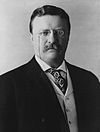L. M. Shaw
This article needs additional citations for verification. (March 2024) |
L. M. Shaw | |
|---|---|
 | |
| 43rd United States Secretary of the Treasury | |
| In office February 1, 1902 – March 3, 1907 | |
| President | Theodore Roosevelt |
| Preceded by | Lyman J. Gage |
| Succeeded by | George B. Cortelyou |
| 17th Governor of Iowa | |
| In office January 13, 1898 – January 16, 1902 | |
| Lieutenant | James C. Milliman |
| Preceded by | Francis M. Drake |
| Succeeded by | Albert B. Cummins |
| Personal details | |
| Born | Leslie Mortier Shaw November 2, 1848 Morristown, Vermont, U.S. |
| Died | March 28, 1932 (aged 83) Washington, D.C., U.S. |
| Political party | Republican |
| Spouse | Alice Crenshaw |
| Children | 3 |
| Education | Cornell College (BA) University of Iowa (LLB) |
Leslie Mortier Shaw (November 2, 1848 – March 28, 1932) was an American businessman, lawyer, and politician. He served as the 17th Governor of Iowa and was a Republican candidate in the 1908 United States presidential election. He was Secretary of the Treasury from 1902 to 1907.[1][2]
Biography
[edit]Shaw was born on November 2, 1848 in Morristown, Vermont, the son of Boardman O. Shaw and Louise Spaulding "Lovisa" Shaw.[3] He attended Cornell College in 1874. Shaw married the former Alice Crenshaw on December 6, 1877, with whom he had three children.
Shaw was a part-time lawyer and part-time apple salesman in Denison, Iowa.[3] He later became a banker.
He became active in politics during the 1896 presidential election where he held speeches in favor of William McKinley, arguing in favor of his monetary policy.[3]
In 1898, he became the 17th Governor of Iowa, serving until 1902. He then became the U.S. Secretary of the Treasury under President Theodore Roosevelt from 1902 to 1907.
Like his predecessor Secretary Lyman Gage, Shaw firmly believed that the Treasury should serve the money market in times of difficulty through the introduction of Treasury funds. To this end, Shaw bought back the government bonds from commercial banks that owned them, increased the number of government depository banks, and in 1902, he told the banks that they no longer needed to keep cash reserves against their holdings of public funds. The intended effect of these actions was to provide a more elastic currency which would then respond to the needs of the market. The government intervention in the money market reached its height with Shaw. He supported tariff theory according to the New York Times.[4] He resigned on March 3, 1907, to become a banker in New York City. Later that year, the Panic of 1907 took place.[5]
He was a candidate for the Republican Party nomination during the U.S. presidential election in 1908.
After leaving the Presidential Cabinet, he returned to banking, working in New York City. Shaw was a critic of Woodrow Wilson and the League of Nations.[3] He campaigned for Calvin Coolidge and Herbert Hoover.[3] He was a strong supporter of the Smoot-Hawley tariff.[3]
Shaw died in Washington, D.C., and was buried in Oakland Cemetery in Denison, Iowa.
Footnotes
[edit]- ^ Andrew, A. Piatt (1907). "The Treasury and the Banks Under Secretary Shaw". The Quarterly Journal of Economics. 21 (4): 519–568. doi:10.2307/1883587. ISSN 0033-5533. JSTOR 1883587.
- ^ Timberlake, Richard H. (1963). "Mr. Shaw and His Critics: Monetary Policy in the Golden Era Reviewed". The Quarterly Journal of Economics. 77 (1): 40–54. doi:10.2307/1879371. ISSN 0033-5533. JSTOR 1879371.
- ^ a b c d e f "LESLIE M.SHAW DIES; EX-TREASURY HEAD; Member of Roosevelt Cabinet Succumbs to Pneumonia at 84 in Washington. VERMONTER ROSE IN IOWA Apple Tree Seller, Lawyer and Banker Became Governor and National Republican Leader". New York Times. 1932.
- ^ "Site Map - October 11, 1922". The New York Times.
- ^ Andrew, A. Piatt (1908). "The United States Treasury and the Money Market. The Partial Responsibility of Secretaries Gage and Shaw for the Crisis of 1907". American Economic Association Quarterly. 9 (1): 218–231. ISSN 1532-5059. JSTOR 2999998.
Further reading
[edit]- Patton, Eugene B. (1907). "Secretary Shaw and Precedents as to Treasury Control over the Money Market". Journal of Political Economy. 15 (2): 65–87. doi:10.1086/251290. JSTOR 1817458. S2CID 154972226.
External links
[edit]- 1848 births
- 1932 deaths
- 19th-century American politicians
- 20th-century American politicians
- Cornell College alumni
- Republican Party governors of Iowa
- People from Morristown, Vermont
- Candidates in the 1908 United States presidential election
- United States secretaries of the treasury
- Theodore Roosevelt administration cabinet members
- People from Denison, Iowa
- Burials in Iowa


